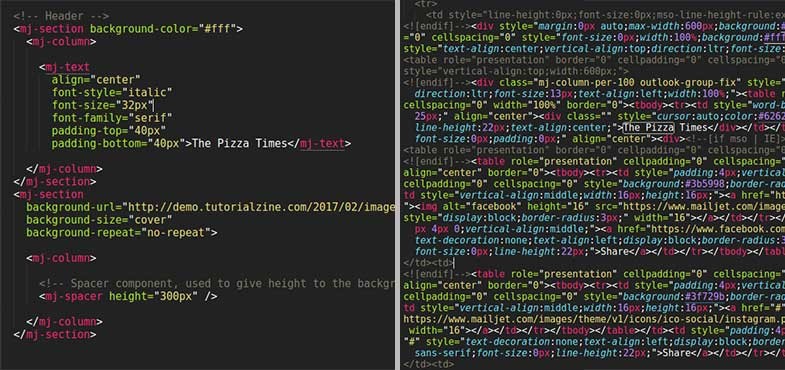
This is what I have so far import mjml2html from 'mjml'įs.writeFile('new.html', html.
#Compile mjml from string code#
Since MJML is an open-source framework, you can hop over to Github to check out all of the code behind the engine.So I generate some HTML and I have an object that contains the HTML called html and I want to write this to a new file but right now it isn't working because and just has NaN in my saved file. I have try to create it in another temp directory, but it is not working like that. This makes it easy to extend and reuse high-level components. mjml will be looking for all files changes in subfolders (layouts and their includes). The MJML engine was built in React.js for its high composability and the way it handles components. The MJML engine then takes care of rendering the sections as expected and in an responsive way. MJML is an engine transpiling -style markup language into responsive email HTML with nested tables and inline CSS.Įssentially, the MJML engine reads what the sections of the email are and what they should look like. In time, MJML components will build and innovate off one another. Say you need a component that’ll display pictures of cats and cat names in a neat, clean layout, just build ! Our goal is for you, the community to own MJML. In addition to quickly plugging in components natively included in MJML, you can also build your own. Want to include an article in your email? All you have to do is to specify a link to an image, a title, a description and a link to the article as attributes in your tag. By using MJML components, you will be able to focus on the content rather than on the tricky - and annoying - part of the style. From low-level components such as to higher-level components like, there’s a component for that. Write high-level code through extensible and reusable components.
#Compile mjml from string update#
Email clients update their specs and requirements regularly, but we geek about that stuff - we’ll stay on top of it so you can spend less time reading up on latest email client updates and more time coding. Your MJML will always be up-to-date and responsive. Building a responsive email is super easy with tags such as and. Say goodbye to endless HTML table nesting or email client specific CSS. Get your speed and productivity boosted with MJML’s semantic syntax. MJML rolls up all of what the Mailjet Developer team has learned about HTML email design over the past few years and abstracts the whole layer of complexity related to responsive email design. And that’s how MJML was born.Īfter learning so much from our users, we wanted to give back to the community by sharing this open-source framework to make responsive email easier and redefine the coding experience once and for all. Depending on how you use MJML, you have two options: 1 Using the MJML online editor, all you have to do is click the Render button on the bottom left part of the editor so that your email is rendered, then click on HTML on the top left part of the editor 2 Using the MJML engine on your machine, you can run mjml input.mjml -o output. The team started by creating a new markup language that would abstract the complexity of responsive HTML and automatically generate it. This means that finding a way to code responsive email easily and quickly is pretty important. Having been knee deep in email for five years, the Mailjet team saw two things: a) email HTML is antiquated and not developer friendly b) a growing trend of email being viewed on mobile and tablet and the number of screens is only increasing. MJML was created in early 2015 by a team of Mailjet developers while they were working on Passport, Mailjet’s drag-and-drop interface for creating responsive emails. Why we set out to tackle the challenge of coding responsive email Guess what happens if that’s where you added your CSS? Yes, it’s removed.īottom line is, responsive email is hard and it’s even harder to use HTML to guarantee beautiful, user-friendly email that displays exactly the way you want no matter where it lands. Gmail for example, removes the entire header section of your email’s HTML. Each client renders HTML in its own way and some don’t even support HTML, which can cause delivery issues. The tricky thing is though, that HTML for email is very different from the HTML you might have come to know (and perhaps love) from the web.

That’s why responsive email design is so important. With all of these variables of where your email could land, it can be stressful to create a one-size-fits-all email design. On top of that, there are a lot of email clients out there. Beyond the third screen (mobile), we’re moving onto smart watches and possibly even VR devices! According to Litmus, mobile now represents no less than 50% of where email is read.

These days, we email everywhere - standing up, sitting down, sleeping.and on a ton of devices too.


 0 kommentar(er)
0 kommentar(er)
